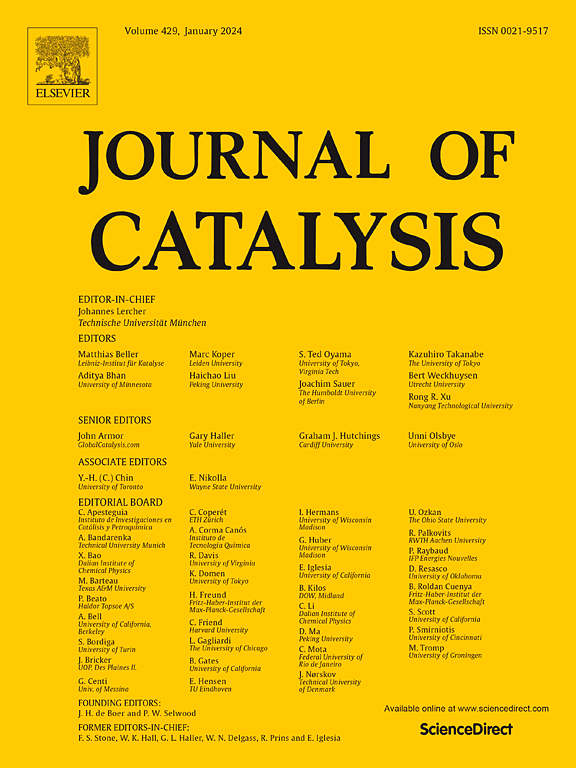温和条件下正丁烷绿色氧化氧转移的选择性调控:性能和机理
IF 6.5
1区 化学
Q2 CHEMISTRY, PHYSICAL
引用次数: 0
摘要
开发一种绿色高效的惰性正丁烷催化生产甲基乙基酮(MEK)的工艺对于C4化工行业至关重要,但如何在温和条件下实现分子氧的高效活化,生成活性氧中间体并选择性地将其转移到目标产物上仍然是一个挑战。在此基础上,提出了基于质子耦合电子转移(PCET)的协同催化策略,并对Cu(TBBD)催化剂液相空气氧化正丁烷的氧化性能和机理进行了评价和分析。通过对工艺条件的细致优化,以及可重复使用性和可扩展性的综合评价,该催化体系在温和的反应温度下表现出优异的氧化性能。该反应体系干净,产物MEK选择性为74 %,乙酸选择性为26 %,具有较高的应用价值。热力学和动力学研究表明,该反应体系为吸热无序反应,表观活化能为68.83 kJ/mol,可以用零级动力学来描述。通过原位红外(IR)、ESR、ESI-HRMS等先进仪器及实验推导,揭示了其机理是在PCET过程中,氧分子被Cu(TBBD)和NHPI有效协同活化,生成烷氧基和过氧化物自由基中间体,直接氧化底物生成相应的高值化学品。DFT计算进一步证明了反应机理的合理性。为正丁烷工业氧化反应器设计和工艺迭代提供了可靠的依据。本文章由计算机程序翻译,如有差异,请以英文原文为准。

Selective regulation of oxygen transfer for green oxidation of n-butane under mild conditions: Performance and mechanism
Developing a green and efficient catalytic process for inert n-butane to produce Methyl-Ethyl-Ketone (MEK) is critical for the C4 chemical industry, however, realizing efficient activation of molecular oxygen under mild conditions to produce reactive oxygen intermediates and selectively transfer them to the target product still faces challenges. Herein, a synergistic catalytic strategy based on Proton-Coupled Electron Transfer (PCET) is developed, and the oxidation performance and mechanism of our Cu(TBBD) catalyst for air oxidation of n-butane in liquid-phase is evaluated and analyzed. Through meticulous optimization of process conditions, and comprehensive evaluation of reusability and scalability, this catalytic system shows excellent oxidation performance under mild reaction temperature. Besides, the reaction system is clean, and the products have high-value application prospects (MEK selectivity of 74 %, and acetic acid selectivity of 26 %). Thermodynamic and kinetic studies exhibit that the reaction system is endothermic and disordered, and can be well described by the zero-order dynamic with an apparent activation energy of 68.83 kJ/mol. The mechanism is revealed by some advanced instruments (in-situ IR, ESR, ESI-HRMS, etc.) and experimental derivations to be that oxygen molecular is efficiently synergistic activated by Cu(TBBD) and NHPI to generate alkoxy and peroxide free radical intermediates through the PCET process, which directly oxidize the substrate to produce the corresponding high-value chemicals. Moreover, DFT calculations further prove the rationality of the reaction mechanism. This work provides a reliable basis for reactor design and technology iteration of industrial oxidation of n-butane.
求助全文
通过发布文献求助,成功后即可免费获取论文全文。
去求助
来源期刊

Journal of Catalysis
工程技术-工程:化工
CiteScore
12.30
自引率
5.50%
发文量
447
审稿时长
31 days
期刊介绍:
The Journal of Catalysis publishes scholarly articles on both heterogeneous and homogeneous catalysis, covering a wide range of chemical transformations. These include various types of catalysis, such as those mediated by photons, plasmons, and electrons. The focus of the studies is to understand the relationship between catalytic function and the underlying chemical properties of surfaces and metal complexes.
The articles in the journal offer innovative concepts and explore the synthesis and kinetics of inorganic solids and homogeneous complexes. Furthermore, they discuss spectroscopic techniques for characterizing catalysts, investigate the interaction of probes and reacting species with catalysts, and employ theoretical methods.
The research presented in the journal should have direct relevance to the field of catalytic processes, addressing either fundamental aspects or applications of catalysis.
 求助内容:
求助内容: 应助结果提醒方式:
应助结果提醒方式:


